Cremat's pulse detection electronics are low noise and can be used to detect optical pulses that are in the femtojoule (10-15 Joules) range using inexpensive and commonly available silicon pin photodiodes. We will assume that the optical pulses are within the 320-1100 nm range of most silicon pin photodiodes and that the duration of the pulses is no longer than a few microseconds total. This page will demonstrate this detection and show the instrumentation needed to perform this.
Hardware needed:
1) Cremat part numbers CR-110, CR-150-R6, CR-150-BOX-R6, and CR-24V assembled as charge sensitive preamplifier instrument as described in Configuration 1.
2) Cremat part numbers CR-200-1us, CR-210, CR-160-R9, CR-160-BOX-R9, and CR-24V assembled as a shaping amplifier instrument as described here.
3) Oscilloscope and (optional) pulse height analyzer.
4) pin photodiode (Hamamatsu model S1223 is used in this demonstration), electrically shielded in a metal housing and well shielded from stray ambient light.
5) Instead of a femtojoule optical test pulse, we will use a small isotopic source (241Am) which deposits a precisely known energy (9.6 femtojoules) to the silicon photodiode. More on this in the next section.
Preparation of the photodiode
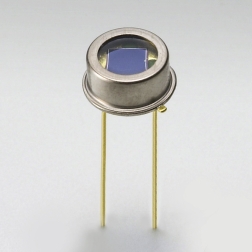
The Hamamatsu S1223 pin photodiode that we will use in our demonstration is pictured above. Although some photodiodes are available with preamplifiers built in to the package, the Hamamatsu photodiode we are using has no such preamplifier built in and is simply a silicon pin photodiode mounted in a small hermetically sealed package having a borosilicate glass window.
Pictured below is the photodiode mounted in a light-tight die-cast aluminum housing. The two leads of the photodiode are soldered to a BNC connector. A small 241Am isotopic test source is taped to the entrance window of the photodiode. The window allows some of the gamma rays (60 keV) and X-rays to pass into the silicon pin photodiode. Although 241Am also emits alpha-particles, the pin photodiode entrance window filters these out, so only the gamma and X-rays are detected.

The advantage of using a 241Am isotopic source as our test pulse rather than an optical test pulse is that the magnitude of the signal from the 241Am source is precisely known. The most identifiable emission is the 60 keV (9.6 femtojoule) gamma ray, because it is the highest energy emission which is reasonably frequent. When one of the 60 keV gamma rays is absorbed by the silicon within a pin photodiode, the silicon is ionized producing electron-hole pairs and the resulting signal is detected by the readout electronics. The ionization rate of gamma-rays absorbed in silicon is 3.6 eV per electron, so a 60 keV gamma ray produces 16,700 ionized electronic charges within the pin photodiode.
In the following demonstration we will measure the signal from our electronics resulting from this signal and infer the response due to an optical signal of similar energy.
Connecting the preamplifier
The charge sensitive preamplifier has a BNC input connector, which we connected directly to the BNC connector on the photodiode housing. Although a coaxial cable could be used between the photodiode and preamplifier, the noise performance would degrade slightly with this added cable length. The photodiode is biased using circuitry in the CR-150-R6 board which AC couples the preamplifier to the photodiode. The bias circuitry is diagrammed here, and -30 volts bias is applied to the 'bias in' connector.
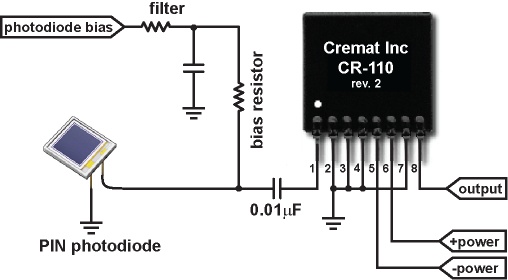

Preamplifier output
The output of the preamplifier is shown in the scope trace below. Although the signals are clearly above the noise in this example, the noise level is significant. The shape of each pulse is a 'tail pulse', which is a fast rise time and slow exponential decay. Because we are applying a negative 30V bias to the circuit shown above, the signal pulses from the preamplifier are negative. Were we to instead use a positive 30V bias and reverse the leads of the photodiode within the housing (thereby maintaining the reverse bias across the photodiode), the preamplifier output pulses would be positive.
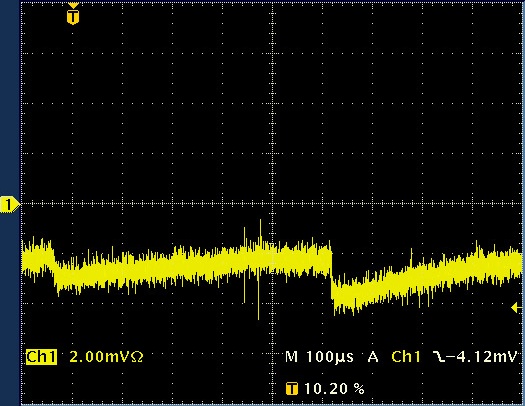
The decay time constant of the exponential decay is 140 microseconds which is a characteristic of the CR-110 preamplifier. The largest signals (those corresponding to the 60 keV gamma rays) produce 16,700 conduction electrons (2.7 femto Coulombs) of charge within the silicon. The specified gain of the CR-110 is 1.4 volts per pico Coulomb with the output unloaded. Because the output impedance of the preamplifier is 50 ohms and the connection at the oscilloscope is terminated by 50 ohms, this gain is halved to 0.7 volts per pico Coulomb. From this we calculate that the 60 keV gamma rays should produce -1.9 mV pulses at the preamplifer output.
Adding a shaping amplifier
We can significantly improve the signal to noise ratio by adding a shaping amplifier to the preamplifier output. The shaping amplifier is a band pass filter that filters out much of the noise at the preamplifier output and also shapes the signal from the 'tail pulse' having a long exponential tail to a Gaussian (or bell-shaped) pulse which returns much more quickly to the baseline. This keeps pulses from 'piling up' on top of each other. Shaping amplifiers can also add more gain to the signal so that they can be more easily measured and digitized.
In this example, we add Cremat's shaping amplifier to perform this shaping. The instrumentation and the output signal are shown below.
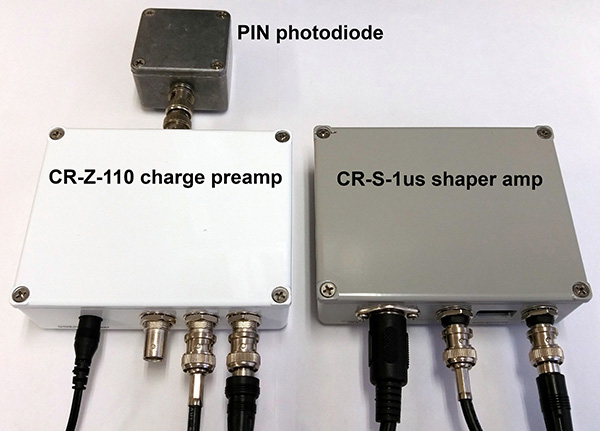
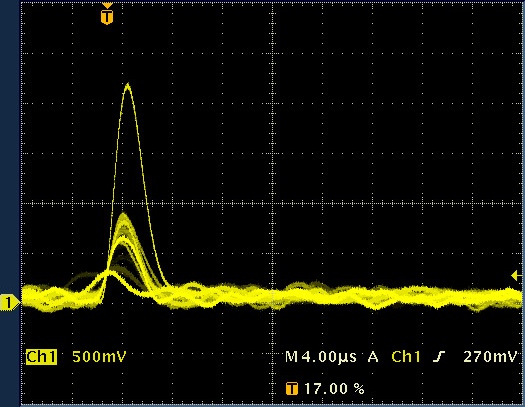
The 60 keV gamma ray produces the 2.2 volt pulse seen in the scope trace. The smaller pulses are due to various X-ray emissions from the isotopic source.
Using a pulse height analyzer, we analyze the pulses produced by the detection system resulting in a 'pulse height spectrum' (a histogram of the detected pulse sizes). We also analyzed the pulses from the system without the 241Am isotopic source attached to the photodiode in order to measure the noise level. These two pulse height spectra are shown overlapped below:
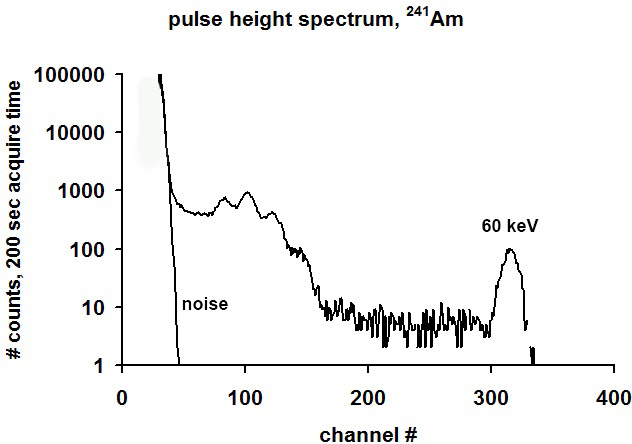
The 60 keV pulse (16,700 electrons) is centered on channel 315. The noise threshold is at channel 46 (2,400 electrons). To be detectable as a pulse above the noise, we assume that the signal should be about twice this value, or 5,000 electrons in magnitude.
Comparison to an optical signal
The Hamamatsu S1223 photodiode has a sensitivity that varies as a function of wavelength [see ref], but the sensitivity at the middle of its usable range (at 700 nm) is 0.5 A/W. This sensitivity can also be read as 0.5 coulombs per joule. And further converting from coulombs to electrons we get a sensitivity of 3000 electrons per femtojoule. From the previous discussion, we found that a photodiode signal of 5000 electrons should be detectable above the noise, and given the specified sensitivity of the Hamamatsu S1223 pin photodiode we can conclude that an optical signal (700 nm) of 2 femtojoules can be clearly detected above the noise. The assumption is that the optical signal must be relatively short in duration (less than a few microseconds).